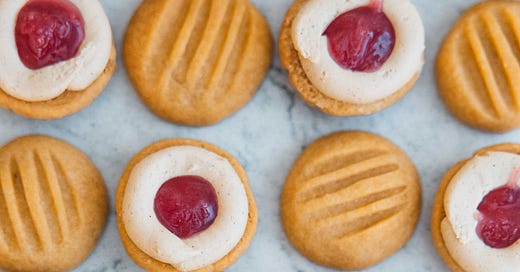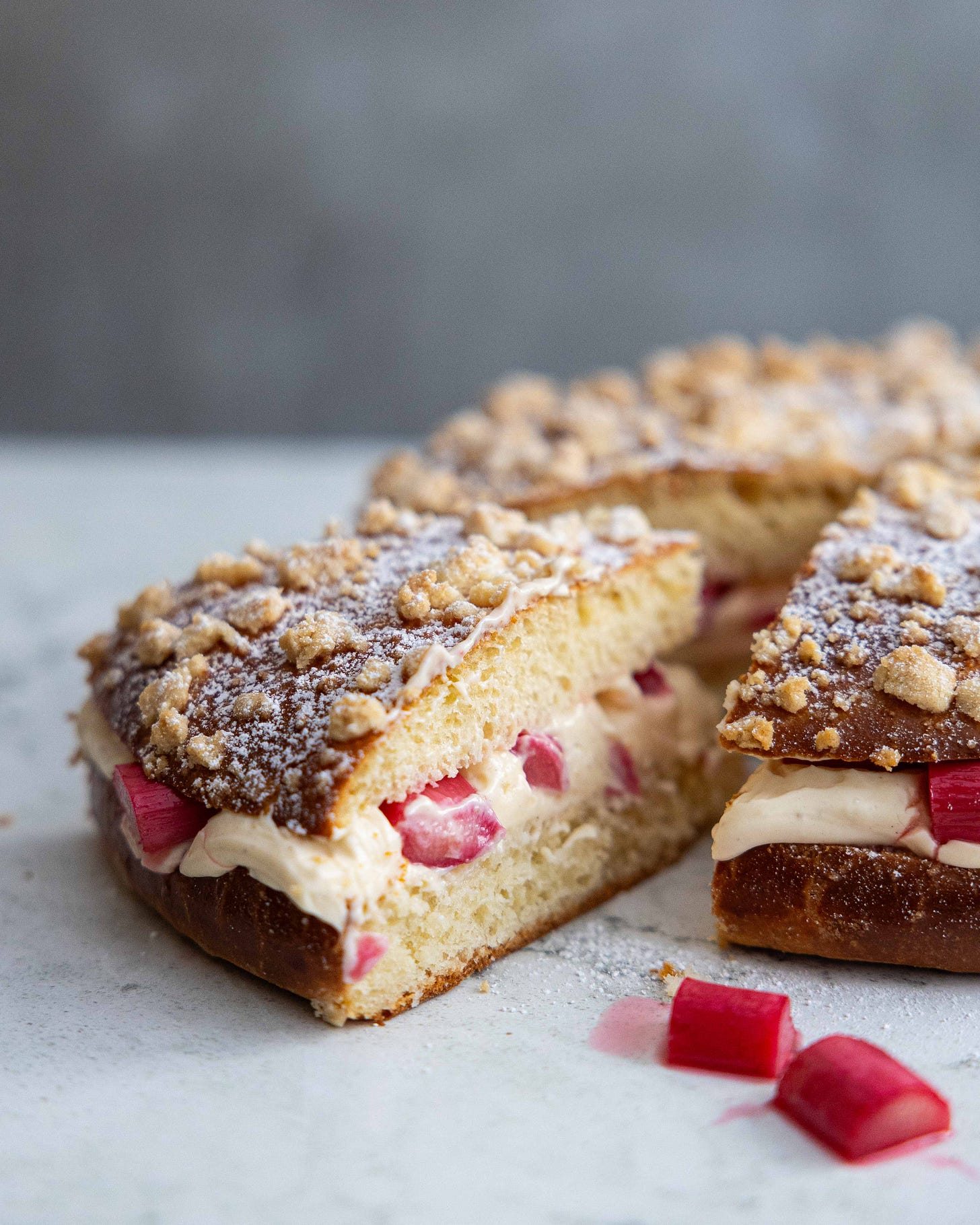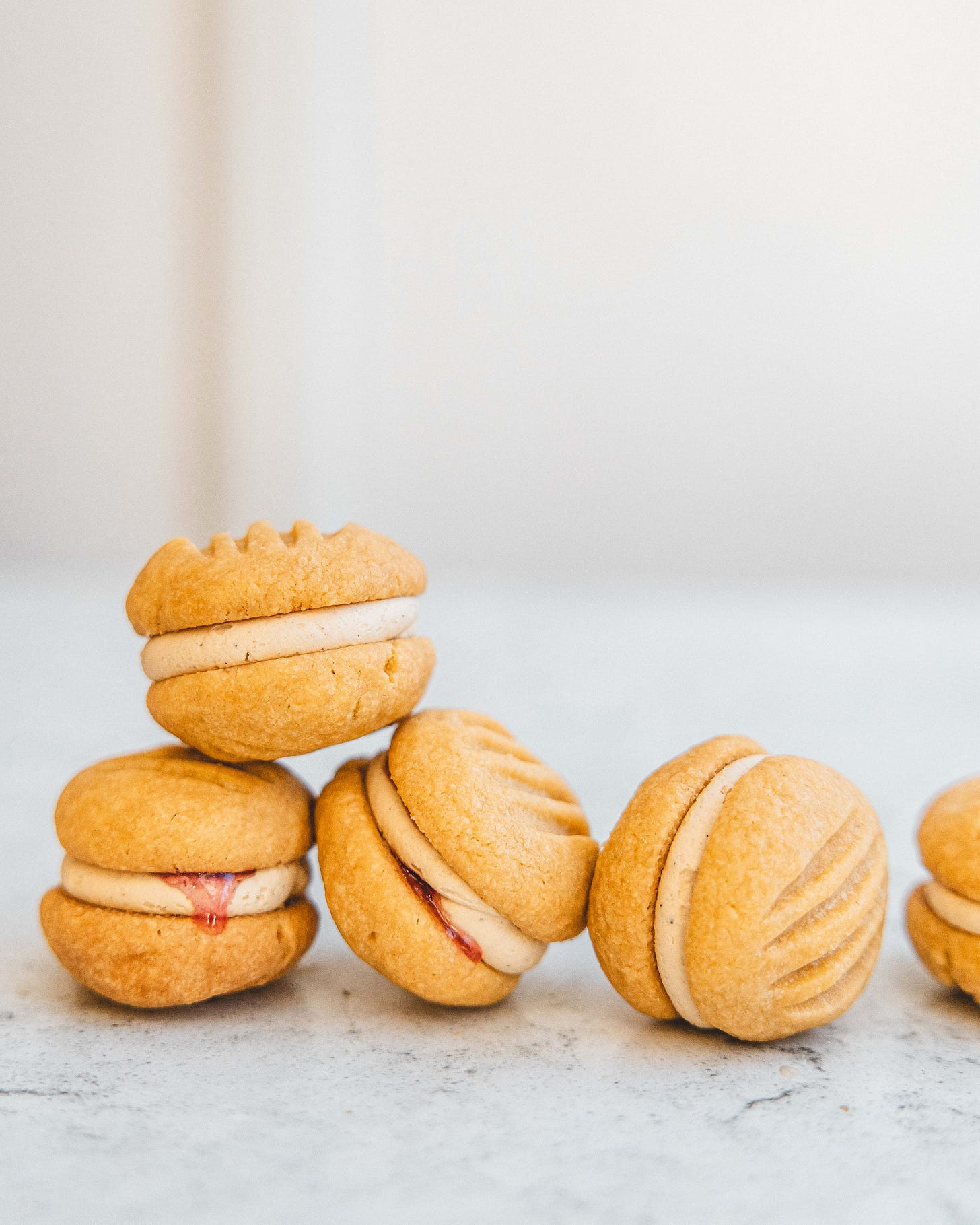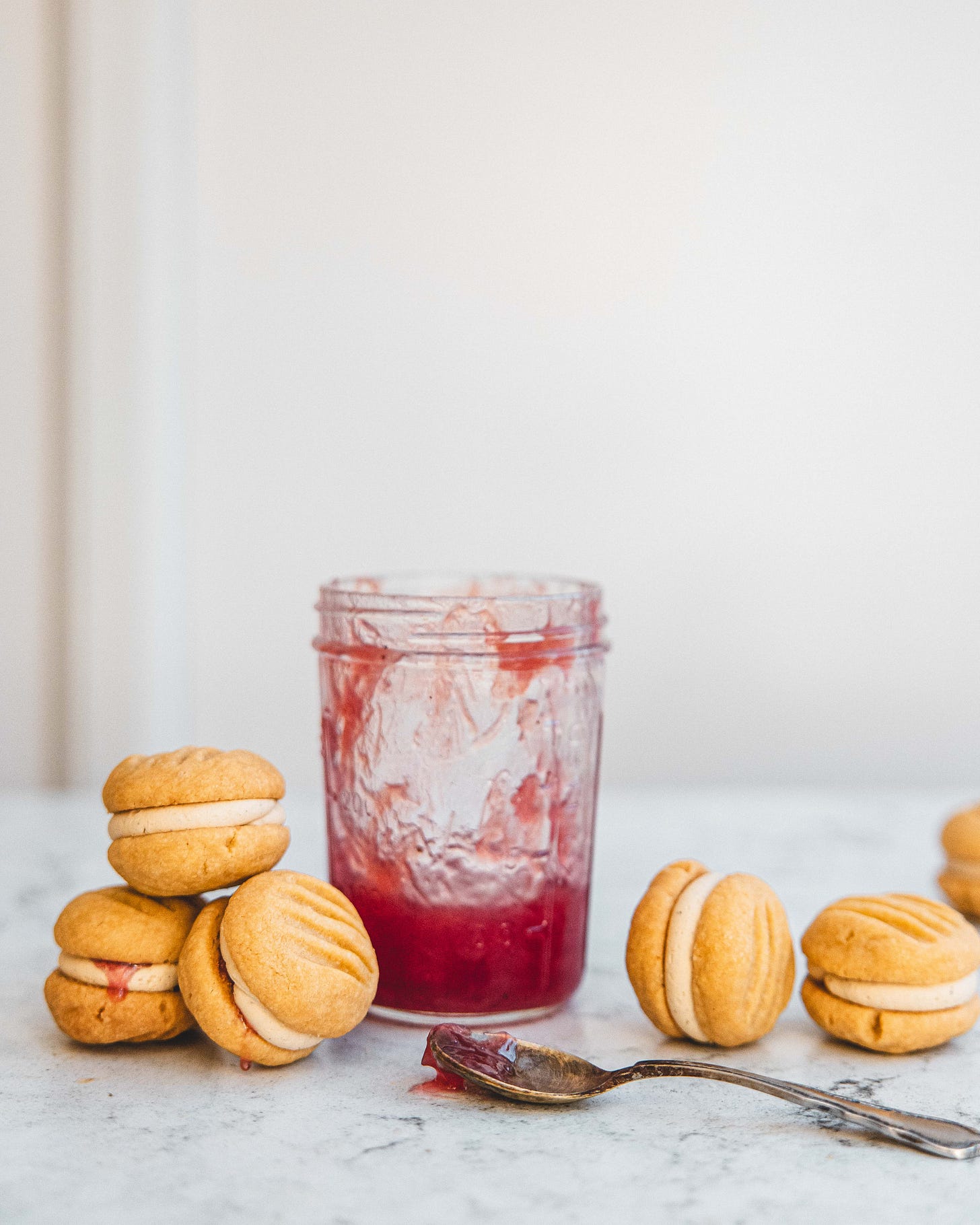This weeks newsletters are all about one of my favourite combinations, rhubarb and custard. A total classic, a favourite of childhood and a favourite of adulthood. The sharp rhubarb goes exceptionally well against the sweet creamy custard, it’s like an opposites attract kind of situation. Over the years I have written a LOT of recipes with this combo and feels, to me at least, like an annual tradition, a challenge to come up with a new way to spin those flavours into something delicious. For this years celebration of rhubarb and custard I have got two fabulous recipes for you. For free subscribers I have got a little twist on a classic, a rhubarb and custard melting moment. Melt in the mouth shortbread cookies made with custard powder, sandwiched together with a vanilla scented buttercream and vibrant pink rhubarb jam. For Second Helpings subscribers I have something a little more involved, a take on the French Tarte Tropezienne. This is the absolute perfect thing for serving a crowd, like a giant sharing loaf of brioche, great for having friends over at the weekend. The brioche in question is shaped like a giant burger bun and then, traditionally, it is covered in pearl sugar but, in this recipe, I have added a streusel topping for added texture. The brioche is split and brushed with a cardamom syrup before being filled with the dreamiest of custard fillings, a creme diplomat, before finally adding a layer of roasted rhubarb. Its a bit special and its a fabulous little weekend project bake.
Before we get to the Tarte Tropezienne lets deal with the biscuit situation. Now I have been making versions of these cookies for many many years, they were the sleeper hit back in my market bakery days and they are also one of the easiest cookies/biscuits to make. One of the key ingredients to this classic recipe is custard powder, it adds a little colour and flavour to the biscuits but it also helps with the melt in the mouth texture. The reason for this is starch, custard powder is almost entirely made up on cornflour, with added colourings and flavourings, so the good news is, if you don’t live in a commonwealth country (where custard powder is very easy to come by) you can simply substitute cornstarch. Because the starch is gluten free it helps to create a light and crumbly texture.
The jam filling is my most frequently made jam recipe, mainly because every year when forced rhubarb comes into season I make a large batch that I slowly make my way through over the coming months. It is legitimately my all time favourite jam and its well worth making a few jars. I have shared this recipe before but have included it below so you don’t have to go hunting for it.
Note: as per some requests last week you will know be able to find a printable PDF of the recipe at the bottom of every post
Rhubarb and Custard Melting Moments
Makes about 15
250g unsalted butter, room temperature
½ tsp vanilla bean paste
85g icing sugar
250g plain flour
40g custard powder (or cornflour if you cant find it)
¼ tsp salt
Vanilla Buttercream
25g unsalted butter, very soft
50g icing sugar
1/4 tsp vanilla bean paste
1 tbsp double cream (or milk)
pinch of fine sea salt
Rhubarb jam, to fill
Preheat the oven to 160ºC (140ºC fan) and line two baking trays with parchment paper. Place the butter, vanilla and icing sugar into a large bowl and beat together until smooth and creamy. Sift the remaining ingredients into the bowl and gently mix together until you form a uniform dough, this can easily be done either by hand with a wooden spoon or with a mixer.
Using your hands roll the dough into small balls (I weigh these, 20g each) and place onto the prepared trays leaving a couple of inches between each biscuit. Using a fork dipped in flour press the fork onto the centre of each biscuit leaving an indent.
Bake the biscuits in the preheated oven for 20-25 minutes or until uniformly coloured. These shouldn't brown around the edges (due to the slightly lower temperature) so if you want to confirm they are fully baked flip one over, there should be a uniform golden colour across the base. If there is a darker, almost damp looking patch in the middle pop them back in the oven for a few minutes.
Allow to cool on the baking trays for five minutes, before transferring to a wire rack to cool completely. Whilst cooling make the buttercream. Place the butter into a large bowl and beat together until smooth and creamy, then slowly add in the icing sugar a little at a time, beating until fully combined. Once you have added all the sugar add the vanilla, cream and salt and beat together until light and fluffy.
To assemble the biscuits place the buttercream into a piping bag fitted with a small plain piping tip a pipe a circle of buttercream around the edges of half the biscuits. Fill the hole left behind with some rhubarb jam and top with a second biscuit (if you’re not making the jam you can also use lemon curd or even some salted caramel). These will keep well for around four days in a sealed container.
Rhubarb and Vanilla Jam
Makes 5x340g jars
1kg forced rhubarb, cut into small chunks
Juice of 1 lemon
800g caster sugar
1 vanilla pod
Before you start the jam, first sterilise the jars. Preheat the oven to 160ºC (140ºC Fan) and wash the jars in hot soapy water before rinsing out, but not drying. Place the jars onto a baking tray and pop in the oven for 10 minutes, at which point the jars should be dry. For the lids pop those in a bowl of boiling water and leave to soak for a few minutes, set aside until ready to use.
Pop a couple side plates in the freezer.
Add the rhubarb to a large stock pot, along with the lemon juice, and cook over medium heat until the rhubarb starts to soften. Add the sugar and seeds scraped from the vanilla, along with the pod itself, to the rhubarb and cook for a couple minutes or until the sugar is no longer visible and you have a pot of very juicy looking rhubarb. Turn the heat up to high and cook for about 10 minutes, stirring occasionally, or until the jam reaches setting point.
To test the jam has been cooked to the right temperature there are a few different methods you can use. Firstly, you can use a jam or candy thermometer and check that the temperature reaches between 104ºC and 105ºC. Secondly you can use the wrinkle test. For this method I find it useful to start testing after about 6 minutes of cooking. Take one of the frozen side plates from the freezer and spoon a small amount of jam onto the plate and pop back in the freezer for 30-60 seconds. Use your finger to push through the jam. If the jam wrinkles when pushed it has reached setting point and you can stop cooking. If the jam still seems liquid and loose, cook a little further, testing as you go.
Once cooked to the correct temperature let the jam sit for a couple minutes before carefully decanting into the still warm sterilised jars, sealing immediately. Once sealed the jam will keep for 6 months, once opened they should be stored in the fridge.








Thanks for the new option to print the recipe!
I’ll be trying your recipe tomorrow...it had me salivating !!